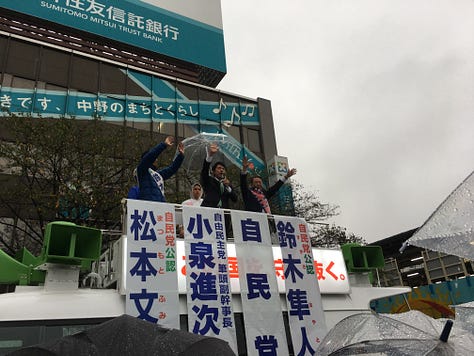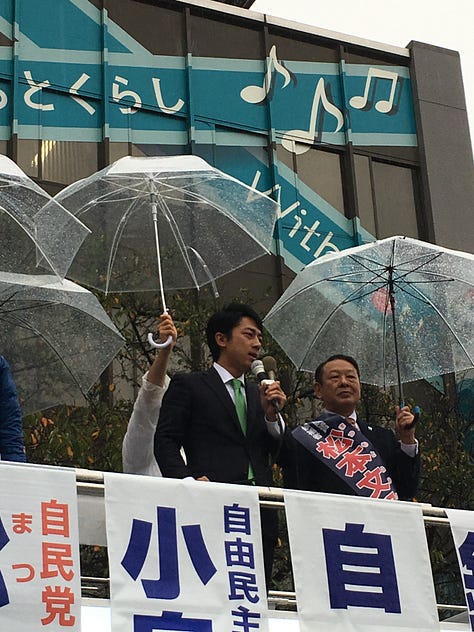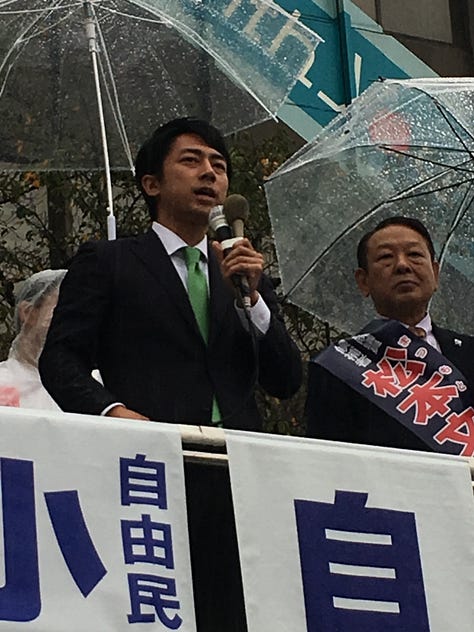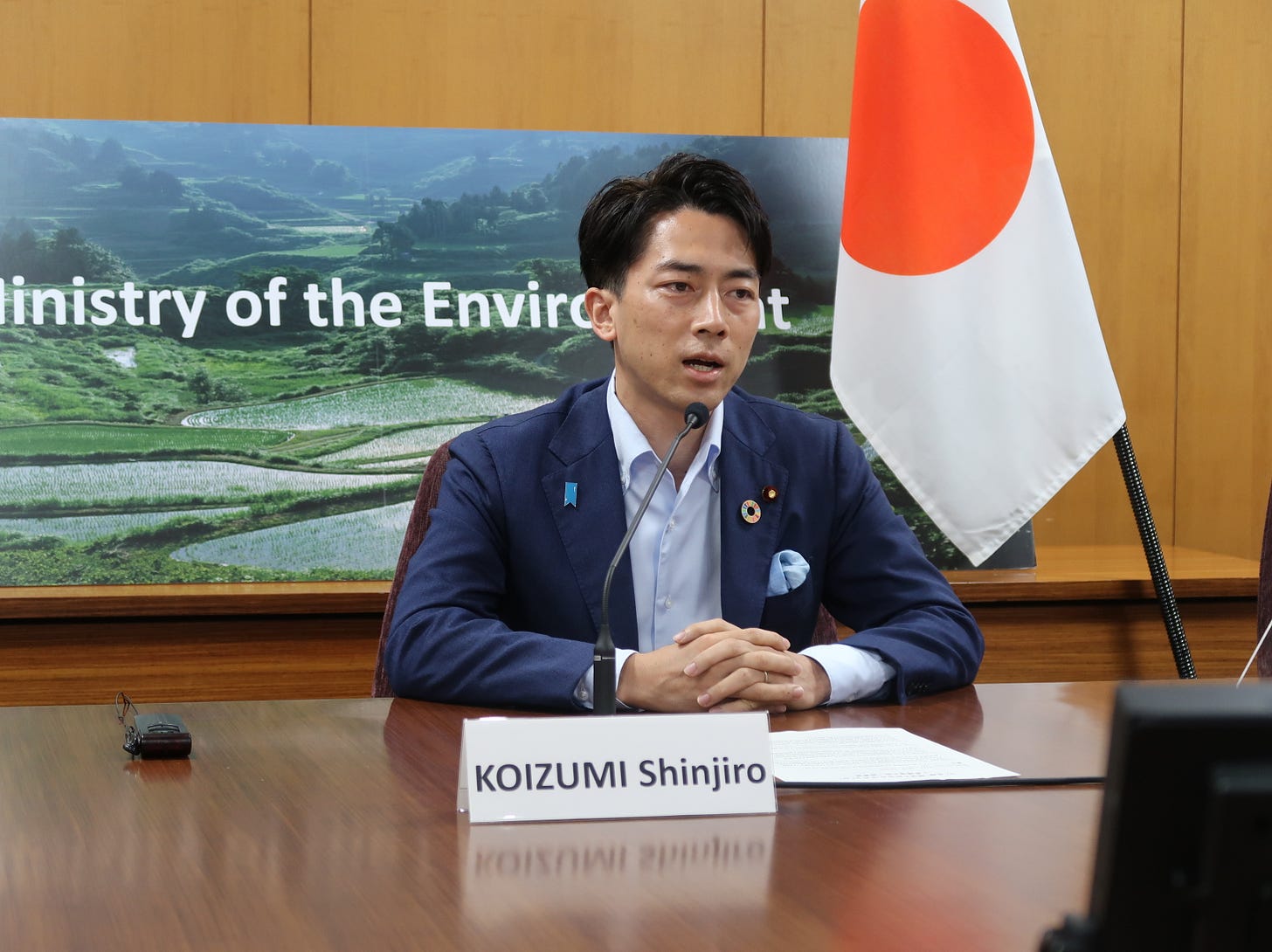Thank you for reading Observing Japan. This post is available to all readers.
If you are looking for timely, forward-looking analysis of the stories in Japans’s politics and policymaking that move markets, I have launched a new service through my business, Japan Foresight LLC. For more information about Japan Foresight’s services or for information on how to sign up for a trial or schedule a briefing, please visit our website or reach out to me.
This is part of a continuing series on the LDP’s free-for-all leadership election. Subscribe below to follow all of my coverage of the 27 September election.

In 2017, I was in Tokyo for the week leading up to the general election and the election itself. While I was there, I made a point of seeing as many stump speeches as possible. When I saw that Koizumi Shinjirō would be speaking outside of Nakano station on the Saturday afternoon before election day, I figured it was time to see the younger Koizumi – who had been regarded as a prime minister-in-waiting since he inherited his father Junichirō’s seat in Kanagawa’s eleventh district in 2009 – on the stump.
It was a rainy afternoon. It rained for most of the week leading up to the election, and poured on election day. But despite the rain – and despite Shinjirō’s arriving late from a stump speech in Yamagata – the plaza in front of Nakano Station was packed, a veritable sea of umbrellas that did not recede despite the weather and the delay. His stump speech was not especially remarkable, though he spoke energetically about the Liberal Democratic Party (LDP) as a party for the “whole nation,” what I think is the essence of the “one-nation conservatism” of LDP reformists like former prime minister Suga Yoshihide, Ishiba Shigeru, and Koizumi himself.



But I did come away convinced that for all of the hype surrounding him, he is a genuine political talent, different in style from his “rock star” father but no less gifted a political communicator. And now the forty-three-year-old Shinjirō has indicated that he will enter the race for the LDP’s leadership.
The challenge of understanding Shinjirō is that it is difficult to see the man himself through memories of his father and through sky-high expectations for his political future. There has never been a time when he was not one of the most popular politicians in the country. Less than a year after he was first elected to the Diet, the LDP featured him in a campaign commercial ahead of the 2010 upper house election, and deployed him widely during that campaign. Two years into his career, the LDP named him to lead the LDP’s youth division. He was only thirty years old.
In this, there are certain similarities with the late Abe Shinzō. Koizumi, like Abe, was first elected when the LDP went into opposition, a moment when the LDP was in crisis and uncertain about how to reverse its fortunes. Both sons of prominent LDP politicians, both inherited high expectations and were not shy about using the outsized platforms they enjoyed even as first-term lawmakers to pressure LDP leaders to change course. Koizumi, for example, defied party leaders to vote against a postal reform bill in 2012, criticized the party’s leadership for its ambivalence about the Trans-Pacific Partnership (TPP), and demanded that party leaders abandon the consumption tax hike plan concluded in cooperation with the Democratic Party of Japan (DPJ)-led government. And like Abe, Koizumi is aiming for the premiership after only five elections to the House of Representatives.
But there are some important differences. Whereas Abe’s rise was meteoric – he was named deputy chief cabinet secretary and LDP secretary-general after only two elections – Koizumi’s rise has been more patient and methodical. Some of these differences are circumstantial. Abe was elevated because the LDP was in crisis and party leaders wanted to tap his youth and popularity. After 2012, Koizumi was serving in a party that was dominant, led by a prime minister who was virtually unchallenged.
Nevertheless, Koizumi’s record during Abe’s tenure is largely one of patience. After retaking the LDP’s leadership and becoming prime minister again, Abe kept Koizumi on as head of the youth division – even though Koizumi had supported Ishiba in the 2012 leadership election – and, while there was speculation that he could challenge Abe from this post, Koizumi served dutifully. He received his first government post in September 2013, becoming the parliamentary secretary for the agency responsible for Tohoku’s reconstruction (having to navigate around his father’s opposition to nuclear energy). But he was careful not to move too quickly. When Abe asked him to join the cabinet in October 2015 – when Abe’s approval ratings had sunk due to the national security legislation and he thought Koizumi could help – Shinjirō declined both a cabinet post and a post as an adviser to the prime minister, saying it was too soon in his career.1
What I found most interesting about this period of Koizumi’s career is that while he could have leaned into his wunderkind status and bought into the media hype, he instead focused on important but unglamorous policy areas, what Nikkei political columnist Shimizu Masato described as doing political dirty work, distinct, he said, from both Abe and his father. After turning down Abe in 2015, he became the chairman of the LDP’s agriculture policy committee, an important role when the Abe government was trying to bring TPP over the finish line but hardly a flashy, public-facing role. It not only involved Koizumi in helping make the case for TPP to the LDP’s rural constituents, it also enabled him to learn agricultural issues thoroughly, an essential education for a future LDP leader. Koizumi was not merely a passive learner, though. He also pushed for the LDP to take on further reform of Japan’s agricultural cooperatives.
It was during this period that Koizumi also immersed himself in social security reform. Tapped to head the “Post-2020 Economic and Fiscal Plan” subcommittee of the party’s fiscal reform committee, Koizumi was tasked with studying what became known as “social security for all generations,” studying ways to limit social security spending and shift more of it from the old to the young. Like agriculture policy, this was a high-stakes but unglamorous policy area that a future prime minister would have to master. It was also a role that allowed him to lean into his father’s legacy, who pursued “reform without sanctuary” and prioritized fiscal consolidation. This subcommittee was not narrowly focused on social security, as it ventured into other areas, including labor market reform, what Koizumi called Japan’s answer to Germany’s Agenda 2010 reforms.
When Abe, reeling from scandals, reshuffled his cabinet again in 2017, some in the party hoped that he would include Koizumi in his government, but he remained in a party role, moving up to become the principal deputy secretary-general. In this capacity, he dutifully supported the Abe government in the October 2017 general election, delivering 70 stump speeches in 20 prefectures during the campaign.
But as Abe’s tenure lengthened, Koizumi sharpened his critique of the prime minister. He was never an Abe loyalist, and as he and others began looking to the post-Abe future, he began articulating his own vision of politics. Like Ishiba, he criticized Abenomics for its overdependence on macroeconomic policy for growth. Along with other young LDP backbenchers, he criticized the prime minister’s dominance of policymaking. He was forthright in his criticism of Abe’s handling of the Moritomo and Kake Gakuen scandals. And, as I noted in the introduction, he used his campaigning in 2017 to begin articulating a vision of the LDP as a national party (国民政党) that would work on behalf of all Japanese, again a Japanese answer to Britain’s “one-nation conservatism.” This is in contrast to Abe’s national-greatness conservatism, with its focus on removing postwar restraints on national power. Instead, Koizumi emphasized strengthening individuals and society, promoting diversity and tolerance, and moving beyond ideology. “It is not the time to argue about conservative or liberal, right or left. It is a politics of doing that which needs to be done,” he said. His opposition to Abe led him to support Ishiba’s challenge to the prime minister in the 2018 LDP leadership election, when he cautioned Abe against suppressing dissenting opinions within the party.
After the LDP leadership election, he remained focus on political reform – taking up parliamentary reform, for example – and organizing study groups with other young LDP lawmakers, which included taking a growing interest in national security. He also continued to work within the party to develop proposals for social security reform, including a proposal to break up the Ministry of Health, Labor, and Welfare from a perch as chair of the party’s health, labor, and welfare committee.
Despite his vocal criticism of Abe, in September 2019 the prime minister brought Shinjirō into the cabinet for the first time as environment minister, becoming at thirty-eight the third-youngest cabinet minister ever and one of thirteen first-time ministers in that cabinet reshuffle. It was not only an opportunity for Koizumi to be tested as a cabinet minister – both in terms of running an organization and facing questions in the Diet – but also for him to learn a new policy area that would be relevant for a future prime minister. His appointment reflected not only Abe’s desire to highlight a future leader while neutralizing a critic; it also reflected Suga’s influence, who encouraged Abe to bring Suga’s fellow Kanagawan into the government. Of course, he quickly stumbled in the role, when he was criticized for talking about making fighting climate change “cool and sexy.” The response to these comments revealed the extent to which Koizumi, even in a lower-tier cabinet post, would be under a microscope. His comments and actions received closer scrutiny than ever before, and he was also under pressure from other governments over Japan’s climate policies. Nevertheless, despite these constraints, Koizumi was able to use his post, which he retained after Suga succeeded Abe in September 2020, to press for more ambitious climate policies over the resistance of the Ministry of Economy, Trade, and Industry (METI) and industrial actors, ultimately facilitating the Suga government’s adoption of a 2050 net-zero target in late 2020.
Suga’s decision not to run again was a blow to Koizumi, who stood by the embattled prime minister until the very end and even received some criticism from other young lawmakers for a public declaration of support even after it became clear that Suga was doomed. He backed Kōno Tarō, his fellow Kanagawan reformist, in the 2021 LDP leadership election, and after Kishida Fumio took power, he left the government and settled into a second-tier party post, speaking up on behalf of some of his pet policies but otherwise keeping quieter than virtually any other period during his career. However, as the LDP became more embroiled in the kickback scandal, he stepped up his activities again, joining with Suga to press for an end to the LDP’s factions and calling for Abe faction leaders to be expelled from the party. It was still unclear whether he would run for the LDP’s leadership, particularly if Kishida were to seek reelection, although the outlook appeared to shift in early August when the elder Koizumi gave his blessing to a leadership bid by his son.
What becomes clear from looking at the path Koizumi Shinjirō took to his announcement on Tuesday is that throughout his career he has been more workhorse than show pony. He passed up opportunities to take higher-profile jobs that might have flattered his ego but could have set him up to fail; he devoted himself to study unglamorous policies that are particularly important for key LDP constituencies and the party’s future; and he thought hard about the kind of party the LDP should be. He did not simply coast on his famous name or good looks. He supported Abe’s government and LDP but was not merely a follower. He forged close relationships with other junior lawmakers, as well as with patrons like Ishiba and Suga. Unlike Ishiba, he has been careful to avoid openly antagonizing parliamentary colleagues. He may never be the favorite of the LDP’s right wing, but he has also signaled his openness to constitutional revision and been a regular visitor to Yasukuni Shrine, most recently last week, when he, along with fellow prospective candidates Kobayashi Takayuki and Takaichi Sanae, worshipped at the shrine on 15 August.
Given the size of the field, it is difficult for any one candidate to transform the race fundamentally, but Shinjirō may nevertheless have the greatest potential to become the frontrunner in a race that thus far is without one. His presence threatens a long list of candidates. He could outcompete Ishiba and Kōno not only for the support of LDP grassroots supporters but also for the backing of Suga, whose influence among the party’s reformists is considerable.2 Meanwhile, he will challenge Kobayashi for the support of younger lawmakers, who may be more inclined to see the popular Koizumi as the best hope for the party in the next general election. His presence in the race could also diminish the appeal of some of the older mainstream candidates in the race, as he will likely attract outsized media attention and make it difficult for some of the less popular candidates to break through. By the same token, his charisma and media savvy (including social media) could neutralize some of the threat to the LDP from an outsider like Ishimaru Shinji or a right-wing populist party like Hyakuta Naoki’s Conservative Party of Japan.
He is not invulnerable. His resume is thin, having held neither one of the top party leadership posts nor a top cabinet post. He is an effective campaigner and has worked on a range of issues, but his foreign policy experience is limited, which could be a particular weakness in an LDP leadership election that has already been affected by the US presidential election and the prospect of a second Trump administration.3
Nevertheless, he will be a formidable candidate who stands a strong chance of advancing to a runoff – an outright first-round victory may be difficult with a large field – and taking the leadership in the second round. He may already have secured the support of more than forty LDP lawmakers, a number which could grow; if he can receive a quarter of supporters’ votes, he could take at least 100 of the 367 votes. And, if he were to win, he would be well positioned to take the LDP into a general election that preserves the party’s majority. The next test would then be whether Koizumi the younger, new mandate in hand, can outdo his father in bringing unity and stability to a divided party still looking for a new post-Abe identity.
Abe’s offer – and Koizumi’s rejection – may also have been part of the shadow game between Abe and Ishiba, since bringing Koizumi into government would deprive Ishiba, Abe’s greatest rival, of a strategic asset.
His entry is particularly unfortunate for Ishiba, who received Koizumi’s backing in 2012 and 2018 and whom Ishiba praised as a “genius,” with an “aura that attracts people.”
Thin, but not non-existent, as his service as environment minister included significant involvement in international climate diplomacy. He has also studied in the United States at Columbia University and worked at the Center for Strategic and International Studies, and, since his constituency includes Yokosuka, has a certain comfort with defense issues.





